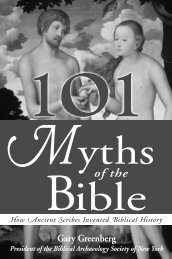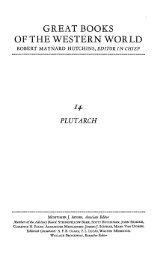Rapture, Revelation, and the End Times - Conscious Evolution TV
Rapture, Revelation, and the End Times - Conscious Evolution TV
Rapture, Revelation, and the End Times - Conscious Evolution TV
Create successful ePaper yourself
Turn your PDF publications into a flip-book with our unique Google optimized e-Paper software.
obin-bobin Left Behind’s Vision of <strong>the</strong> <strong>End</strong> <strong>Times</strong> 39like <strong>the</strong> book of <strong>Revelation</strong>, were widely interpreted not asliteral indications of forthcoming events but as allegoricaldescriptions of spiritual development. The third-century Roman<strong>the</strong>ologian Origen, for instance, argued that <strong>the</strong> establishmentof <strong>the</strong> kingdom of God would be a spiritual event that wouldtake place in <strong>the</strong> hearts <strong>and</strong> souls of believers, not in <strong>the</strong> realworld at any real time. Later, in <strong>the</strong> early fifth century,Augustine, whose work would become an important foundationof orthodox Christian thought, argued that <strong>Revelation</strong> wasan allegory <strong>and</strong> that <strong>the</strong> establishment of <strong>the</strong> Christian churchitself constituted <strong>the</strong> advent of <strong>the</strong> millennium. 3 Its continuedexpansion <strong>and</strong> hegemony was <strong>the</strong> culmination of God’s plan. AsMark Reasoner <strong>and</strong> Stanley Grenz explain in o<strong>the</strong>r chapters inthis volume, interpretations like <strong>the</strong>se, asserting that <strong>the</strong>se textsoffered metaphors for spiritual ideas, have remained popular<strong>and</strong> widespread throughout Christianity ever since <strong>and</strong> remainwidely accepted today.Despite opposition from <strong>the</strong> majority in <strong>the</strong> late Romanperiod, pockets of messianic or apocalyptic thought persisted.For instance, two important collections of prophetic writingsdating from 350 to 340 C.E.—<strong>the</strong> Sibylline texts (a collection ofJewish, Christian, <strong>and</strong> pagan works) <strong>and</strong> <strong>the</strong> First Letter of Johnin <strong>the</strong> New Testament—developed several apocalyptic <strong>the</strong>mes,including <strong>the</strong> messianic role of Constantine as a warrior god,<strong>the</strong> Golden Age of <strong>the</strong> Roman empire, <strong>the</strong> conversion of Jews toChristianity, <strong>the</strong> notion of <strong>the</strong> antichrist, a great end-times battle,<strong>and</strong> <strong>the</strong> second coming of Christ.Such texts, however, represented only pockets on <strong>the</strong> fringes ofChristian thought, for <strong>the</strong> orthodox church, growing powerfulwith <strong>the</strong> blessings of <strong>the</strong> empire, had little need for stories of retribution.Focusing on <strong>the</strong> spiritual character of salvation, orthodoxyviewed <strong>the</strong> church as, if not <strong>the</strong> culmination of a divinehistorical process, certainly a significant event in <strong>the</strong> divine plan—an event that mitigated <strong>the</strong> immediacy of <strong>the</strong> second coming.Indeed, <strong>the</strong> establishment of <strong>the</strong> church rendered previous ideas of<strong>the</strong> end times obsolete, for with <strong>the</strong> church in place, Christ’s salvationcould focus exclusively on <strong>the</strong> spiritual condition of humansouls.robin-bobin





